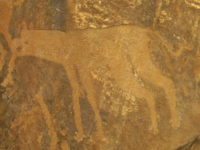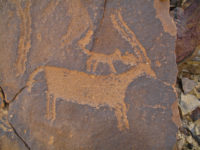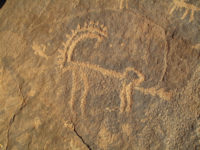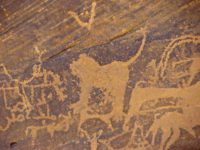Wild Animals
-
Arabian Leopard
Leopards are large and powerful cats, although they are still the smallest of the four cats in this genus. The Arabian leopard is smaller than other subspecies. Their coat varies from pale yellow to tawny, with small spots that are densely packed hollow rosettes. The leopard’s flat cranial profile and tendency to hold its mouth open. The skull profile is distinctively flat, not [...]
-
Arabian Oryx
Oryxes are most easily recognized by their prominent horns, which range in length from 480-700 mm. There is little difference in size of the horns of males vs. females. The long, fairly straight horns are basically in line with the straight facial profile, but curve backward slightly. They are annulated, meaning that the horns possess a series of raised rings wrapping around them in [...]
-
Arabian Wolf
Wolves are the largest members of the Family Canidae. The wolf has a large head with a wide forehead, powerful jaws, bone-crushing teeth, and long, blunt muzzle. Its ears are short and triangular in shape. The neck is thick and muscular, particularly in the male; the limbs are long and powerful. It carries its head down at the same height as its back unless at attention, when it [...]
-
Bezoar (Wild Goat)
The wild goat has long, scimitar-shaped horns that form a large semi-circle curving backward or spiral. The surface of the horns is relatively smooth or has small ripples, in contrast to the transverse ridges found on the ibex’s horns.
-
Cheetah
The cheetah is a large cat with spots and a long tail. The head is distinctive in that it is quite domed, short, and thick. Adapted to high-speed chases on the ground, rather than climbing, the cheetah has long, slender legs and non-retractable claws and digital pads not conducive to gripping. As such, they are portrayed in the rock art standing on all fours, like a dog, rather than [...]
-
Gazelle
In ancient times, there were three species of gazelle in Saudi Arabia: the Mountain Gazelle, the Saudi Gazelle, now extinct, and the Sand Gazelle. Gazelles were once much more abundant on the Arabian Peninsula, but the combination of hunting and overgrazing by livestock have greatly depleted their numbers, leaving only small relict populations
-
Ibex
The ibex is similar to the wild goat in terms of the shape of its head, body, and tail. Like the goat, it has scimitar horns that curve backward in a large semi-circle, but with the addition of a series of regularly spaced transverse ridges along the outer edge of the curve. Ancient artists depicted these ridges distinctly on the more realistic panels, however, where a caprine [...]
-
Lion
The lion is one of the four large felines, second in size only to the tiger. The male lion has a distinctive mane, and their coats have been very valuable through history. Lions have been associated with persons of high status through the millennia and across the continents. Lion hunting has been a sport of royalty and nobility around the ancient world.
-
Onager or African Wild Ass
The wild equine that is depicted in Arabian rock art could have been either the African wild ass (Equus africanus) or the Near Eastern onager, (E. hemionus). Until adequate skeletal remains are found in archaeological sites this question remains open. It is possible that both species occurred in different regions of the Arabian Peninsula. The onager is definitely [...]
-
Ostrich
The ostrich is the largest living bird, lays the largest egg of any living avian species, and has the largest eyes of any terrestrial vertebrate. Ostriches are in the same order, Struthioniformes, with the other flightless living species, kiwis, rheas, emus, cassowaries, and the extinct moa and elephant bird.
-
Striped Hyena
The hyena has a dog-like body with strong forequarters and a back that slopes down in the rear. The neck is long and powerful and the muzzle is blunt, with powerful dentition for crushing bones. This species has a pale gray or beige body with black stripes on its sides and a black and white tail. The body hair is long and shaggy, with a crest from head to tail that stands erect [...]










